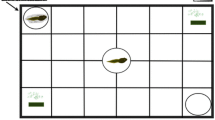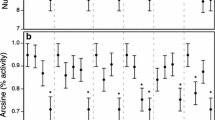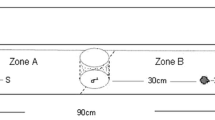Abstract
Animals must balance the conflicting needs to forage and avoid predation. The optimal balance of risk and reward should depend on the individual’s state, particularly hunger status. Satiated individuals are hypothesized to react more strongly to risk than hungry individuals, for which the necessity for food overrides perceived danger. We tested this in wood frog (Lithobates sylvaticus) tadpoles by comparing the response of fasted and fed tadpoles to injured conspecifics (alarm cue) and uninjured conspecifics (control). Food restriction significantly affected the activity levels of tadpoles and the impact of injured conspecific cues on activity. Fed tadpoles responded little to these cues, tending to decrease activity. Hungry tadpoles were more active overall and responded to injured conspecific cues by increasing activity. We propose that hungry tadpoles increase their activity in response to an injured conspecific because, in addition to indicating danger, this cue represents a nutrient source for this opportunistically cannibalistic species, and hungry tadpoles should thus adopt risky behavior to acquire this valuable resource. Differences in hunger may therefore explain variation among studies of tadpole responses to injured conspecifics. Future studies in aquatic organisms should consider the role of hunger status when assessing antipredator behavior.


Similar content being viewed by others
References
Altig, R., M. R. Whiles & C. L. Taylor, 2007. What do tadpoles really eat? Assessing the trophic status of an understudied and imperiled group of consumers in freshwater habitats. Freshwater Biology 52: 386–395.
Altwegg, R., 2003. Hungry predators render predator-avoidance behavior in tadpoles ineffective. Oikos 100: 311–316.
Alvarez, D. & A. G. Nicieza, 2002. Effects of temperature and food quality on anuran larval growth and metamorphosis. Functional Ecology 16: 640–648.
Biro, P. A., M. V. Abrahams, J. R. Post & E. A. Parkinson, 2004. Predators select against high growth rates and risk-taking behaviour in domestic trout populations. Proceedings of the Royal Society B: Biological Sciences 271: 2233–2237.
Bridges, C. M., 2002. Tadpoles balance foraging and predator avoidance: effects of predation, pond drying, and hunger. Journal of Herpetology 36: 627–634.
Carlson, B. E. & T. Langkilde, 2013. A common marking technique affects tadpole behavior and risk of predation. Ethology 119: 167–177.
Carlson B. E. & T. Langkilde, 2014. Predation risk in tadpole populations shapes behavioural responses of prey but not strength of trait-mediated indirect interactions. Oikos (in press).
Cerri, R. D. & D. F. Fraser, 1983. Predation and risk in foraging minnows: balancing conflicting demands. American Naturalist 121: 552–561.
Chivers, D. P. & M. C. O. Ferrari, 2014. Social learning of predators by tadpoles: does food restriction alter the efficacy of tutors as information sources? Animal Behaviour 89: 93–97.
Chivers, D. P., M. H. Puttlitz & A. R. Blaustein, 2000. Chemical alarm signaling by reticulate sculpins, Cottus perplexus. Environmental Biology of Fishes 57: 347–352.
Clark, C. W., 1994. Antipredator behavior and the asset-protection principle. Behavioral Ecology 5: 159–170.
Collins, A. M. & G. W. Gerald, 2009. Attraction of flatworms at various hunger levels toward cues from an odonate predator. Ethology 115: 449–456.
Crump, M., 1990. Possible enhancement of growth in tadpoles through cannibalism. Copeia 1990: 560–564.
Damsgird, B. & L. M. Dill, 1998. Risk-taking behavior in weight-compensating coho salmon, Oncorhynchus kisutch. Behavioral Ecology 9: 26–32.
Eklov, P. & E. E. Werner, 2000. Multiple predator effects on size-dependent behavior and mortality of two species of anuran larvae. Oikos 88: 250–258.
Ferner, M. C., D. L. Smee & Y. P. Chang, 2005. Cannibalistic crabs respond to the scent of injured conspecifics: danger or dinner? Marine Ecology Progress Series 300: 193–200.
Ferrari, M. C. O., F. Messier & D. P. Chivers, 2007. Degradation of chemical alarm cues under natural conditions: risk assessment by larval woodfrogs. Chemoecology 17: 263–266.
Ferrari, M. C. O., B. D. Wisenden & D. P. Chivers, 2010. Chemical ecology of predator–prey interactions in aquatic ecosystems: a review and prospectus. Canadian Journal of Zoology 88: 698–724.
Fraker, M. E., 2008. The effect of hunger on the strength and duration of the antipredator behavioral response of green frog (Rana clamitans) tadpoles. Behavioral Ecology and Sociobiology 62: 1201–1205.
Fraker, M. E., F. Hu, V. Cuddapah, S. A. McCollum, R. A. Relyea, J. Hempel & R. J. Denver, 2009. Characterization of an alarm pheromone secreted by amphibian tadpoles that induces behavioral inhibition and suppression of the neuroendocrine stress axis. Hormones and Behavior 55: 520–529.
Fraser, D. F. & F. A. Huntingford, 1986. Feeding and avoiding predation hazard: the behavioral response of the prey. Ethology 73: 56–68.
Gillette, R., R.-C. Huang, N. Hatcher & L. L. Moroz, 2000. Cost-benefit analysis potential in feeding behavior of a predatory snail by integration of hunger, taste, and pain. Proceedings of the National Academy of Sciences of the United States of America 97: 3585–3590.
Godin, J.-G. J. & S. L. Crossman, 1994. Hunger-dependent predator inspection and foraging behaviours in the threespine stickleback (Gasterosteus aculeatus) under predation risk. Behavioral Ecology and Sociobiology 34: 359–366.
Godin, J.-G. J. & C. D. Sproul, 1988. Risk taking in parasitized sticklebacks under threat of predation: effects of energetic need and food availability. Canadian Journal of Zoology 66: 2360–2367.
Grubb, T. C. & L. Greenwald, 1982. Sparrows and a brushpile: foraging responses to different combinations of predation risk and energy cost. Animal Behaviour 30: 637–640.
Hagman, M., 2008. Behavioral responses by tadpoles of six Australian species to chemical cues from other tadpoles. Herpetological Conservation and Biology 3: 239–246.
Hagman, M. & R. Shine, 2008. Understanding the toad code: behavioural responses of cane toad (Chaunus marinus) larvae and metamorphs to chemical cues. Austral Ecology 33: 37–44.
Hagman, M. & R. Shine, 2009. Factors influencing responses to alarm pheromones by tadpoles of invasive cane toads (Bufo marinus). Journal of Chemical Ecology 35: 265–271.
Harp, E. M. & J. W. Petranka, 2006. Ranavirus in wood frogs (Rana sylvatica): potential sources of transmission within and between ponds. Journal of Wildlife Diseases 42: 307–318.
Heinen, J. T. & J. A. Abdella, 2005. On the advantages of putative cannibalism in American toad tadpoles (Bufo a. americanus): is it active or passive and why? American Midland Naturalist 153: 338–347.
Helfman, G. S., 1989. Threat-sensitive predator avoidance in damselfish–trumpetfish interactions. Behavioral Ecology and Sociobiology 24: 47–58.
Hettyey, A., F. Rölli, N. Thürlimann, A.-C. Zürcher & J. Van Buskirk, 2012. Visual cues contribute to predator detection in anuran larvae. Biological Journal of the Linnean Society 106: 820–827.
Hews, D. K. & A. R. Blaustein, 1985. An investigation of the alarm response in Bufo boreas and Rana cascadae tadpoles. Behavioral and Neural Biology 43: 47–57.
Horat, P. & R. D. Semlitsch, 1994. Effects of predation risk and hunger on the behaviour of two species of tadpoles. Behavioral Ecology and Sociobiology 34: 393–401.
Hossie, T. J. & D. L. Murray, 2011. Effects of structural refuge and density on foraging behaviour and mortality of hungry tadpoles subject to predation risk. Ethology 117: 1–9.
Jefferson, D. M., K. A. Hobson, B. S. Demuth, M. C. O. Ferrari & D. P. Chivers, 2014. Frugal cannibals: how consuming conspecific tissues can provide conditional benefits to wood frog tadpoles (Lithobates sylvaticus). Naturwissenschaften 101: 291–303.
Kats, L. B. & L. M. Dill, 1998. The scent of death: chemosensory assessment of predation risk by prey animals. Ecoscience 5: 361–394.
Kiesecker, J. M., D. P. Chivers & A. R. Blaustein, 1996. The use of chemical cues in predator recognition by western toad tadpoles. Animal Behaviour 52: 1237–1245.
Leary, S., W. Underwood, R. Anthony, S. Cartner, D. Corey, T. Grandin, C. B. Greenacre, S. Gwaltney-Bran, M. A. McCrackin, R. Meyer, D. Miller, J. Shearer & R. Yanong, 2013. AVMA Guidelines for the Euthanasia of Animals: 2013 Edition. American Veterinary Medical Association. Available at: https://www.avma.org/kb/policies/documents/euthanasia.pdf.
Lima, S. L. & L. M. Dill, 1990. Behavioral decisions made under the risk of predation: a review and prospectus. Canadian Journal of Zoology 68: 619–640.
Luttbeg, B. & A. Sih, 2010. Risk, resources and state-dependent adaptive behavioural syndromes. Philosophical Transactions of the Royal Society B 365: 3977–3990.
Maag, N., L. Gehrer & D. C. Woodhams, 2012. Sink or swim: a test of tadpole behavioral responses to predator cues and potential alarm pheromones from skin secretions. Journal of Comparative Physiology [A] 198: 841–846.
MacArthur, R. H. & E. R. Pianka, 1966. On optimal use of a patchy environment. American Naturalist 100: 603–609.
McCormick, M. & J. Larson, 2008. Effect of hunger on the response to, and the production of, chemical alarm cues in a coral reef fish. Animal Behaviour 75: 1973–1980.
Milinski, M. & R. Heller, 1978. Influence of a predator on the optimal foraging behaviour of sticklebacks (Gasterosteus aculeatus L.). Nature 275: 642–644.
Moir, F. & M. J. Weissburg, 2009. Cautious cannibals: behavioral responses of juvenile and adult blue crabs to the odor of injured conspecifics. Journal of Experimental Marine Biology and Ecology 369: 87–92.
Morgan, M. J., 1988. The influence of hunger, shoal size and predator presence on foraging in bluntnose minnows. Animal Behaviour 36: 1317–1322.
Nonacs, P., 2001. State dependent behavior and the Marginal Value Theorem. Behavioral Ecology 12: 71–83.
Persons, M. H., S. E. Walker, A. L. Rypstra & S. D. Marshall, 2001. Wolf spider predator avoidance tactics and survival in the presence of diet-associated predator cues (Araneae: Lycosidae). Animal Behaviour 61: 43–51.
Petranka, J. W., 1989. Response of toad tadpoles to conflicting chemical stimuli: predator avoidance versus “optimal” foraging. Herpetologica 45: 283–292.
Petranka, J. & L. Hayes, 1998. Chemically mediated avoidance of a predatory odonate (Anax junius) by American toad (Bufo americanus) and wood frog (Rana sylvatica) tadpoles. Behavioral Ecology and Sociobiology 42: 263–271.
Petranka, J. W. & D. A. G. Thomas, 1995. Explosive breeding reduces egg and tadpole cannibalism in the wood frog, Rana sylvatica. Animal Behaviour 50: 731–739.
R Development Core Team, 2012. R: A Language and Environment for Statistical Computing. R Foundation for Statistical Computing, Vienna.
Relyea, R. A. & E. E. Werner, 1999. Quantifying the relation between predator-induced behavior and growth performance in larval anurans. Ecology 80: 2117–2124.
Saidapur, S. K., D. K. Veeranagoudar, N. C. Hiragond & B. A. Shanbhag, 2009. Mechanism of predator–prey detection and behavioral responses in some anuran tadpoles. Chemoecology 19: 21–28.
Schoeppner, N. M. & R. A. Relyea, 2005. Damage, digestion, and defence: the roles of alarm cues and kairomones for inducing prey defences. Ecology Letters 8: 505–512.
Sih, A., 1980. Optimal behavior: can foragers balance two conflicting demands? Science 210: 1041–1043.
Smith, R. J. F., 1981. Effect of food deprivation on the reaction of Iowa darters (Etheostoma exile) to skin extract. Canadian Journal of Zoology 59: 558–560.
Stauffer, H. P. & R. D. Semlitsch, 1993. Effects of visual, chemical and tactile cues of fish on the behavioural responses of tadpoles. Animal Behaviour 46: 355–364.
Stoks, R., M. D. Block, F. van de Meutter & F. Johansson, 2005. Predation cost of rapid growth: behavioural coupling and physiological decoupling. Journal of Animal Ecology 74: 708–715.
Takahara, T., Y. Kohmatsu, A. Maruyama, H. Doi, H. Yamanaka & R. Yamaoka, 2012. Inducible defense behavior of an anuran tadpole: cue-detection range and cue types used against predator. Behavioral Ecology 23: 863–868.
Van Buskirk, J. & M. Arioli, 2005. Habitat specialization and adaptive phenotypic divergence of anuran populations. Journal of Evolutionary Biology 18: 596–608.
Werner, E. E. & B. R. Anholt, 1993. Ecological consequences of the trade-off between growth and mortality rates mediated by foraging activity. American Naturalist 142: 242–272.
Whitham, J. & A. Mathis, 2000. Effects of hunger and predation risk on foraging behavior of graybelly salamanders, Eurycea multiplicata. Journal of Chemical Ecology 26: 1659–1665.
Acknowledgements
We thank B. Chitterlings and several anonymous reviewers for feedback that greatly improved this manuscript. We thank T. Maret, A. Stoler, and J. Vreeland for assistance locating field sites for collections and R. Rosier and S. Smiles for help preparing the study site. This work was partially supported by an Animal Behavior Society student research award to BEC. All aspects of this work comply with current laws in Pennsylvania and USA. Animals were collected under permit #488 from the Pennsylvania Fish and Boat Commission, with appropriate site-specific permission granted by the PA Department of Conservation and Natural Resources and the PA Game Commission. Procedures were approved by the Pennsylvania State University Institutional Animal Care and Use Committee (IACUC protocol #33469).
Author information
Authors and Affiliations
Corresponding author
Additional information
Handling editor: Lee B. Kats
Rights and permissions
About this article
Cite this article
Carlson, B.E., Newman, J.C. & Langkilde, T. Food or fear: hunger modifies responses to injured conspecifics in tadpoles. Hydrobiologia 743, 299–308 (2015). https://doi.org/10.1007/s10750-014-2048-5
Received:
Revised:
Accepted:
Published:
Issue Date:
DOI: https://doi.org/10.1007/s10750-014-2048-5




